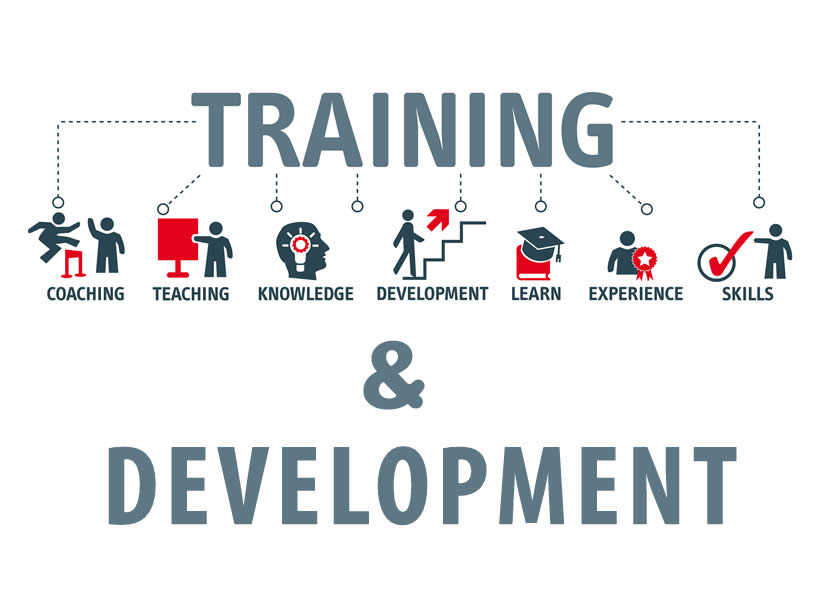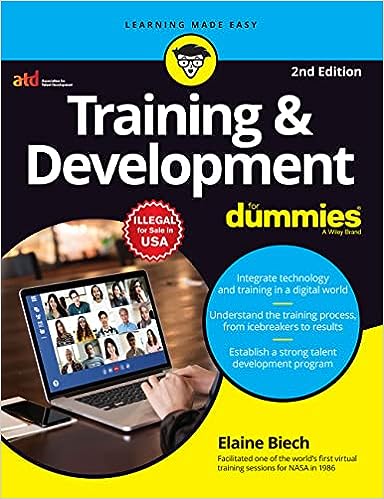
INTRODUCTION
An organization’s ability to operate effectively relies on the effectiveness of its workforce. Through the use of certain approaches, an employee’s capacity may be determined. The management determines the necessity for training based on an employee’s performance.
The management procedures and methods used in the Indian setting are quite complex. By giving the staff the right training, an issue may be resolved. Training and development are used interchangeably. But their meanings are distinct.
Edwin B. Flippo argues that “management development includes the process by which managers and executives acquire not only skills and competence in their present job, but also capacities for future managerial tasks of increasing difficulty and scope.”

TRAINING & DEVELOPMENT BOOKS FOR STUDENTS & BUSINESS OWNERS
Training is the act of increasing the knowledge and skills of an employee for performing a particular job, according to Edwin B. Flippo.
Therefore mentioned description leads to the conclusion that training is the process through which an employee’s knowledge and abilities to do the current job correctly grow. However, development also entails enhancing capacities for future management roles in addition to obtaining information and skills for the current employment.
MEANING
A programme that helps an employee perform by obtaining more information and abilities is referred to as training.
DEFINITION
Training is described by Proctor and Thornton as “the deliberate act of creating mechanisms for learning to occur.”
“Training is the ongoing, systematic development among all levels of workers of those knowledge, abilities, and attitudes which contribute to their welfare and that of the organisation,” say Planty, M.C. Cord, and Efferson.
Elements of Training
The following characteristics of an efficient training programme:
- An ongoing procedure.
- Use of current knowledge and abilities effectively.
- Extending current knowledge and abilities to meet future needs.
- Assisting the worker in locating his current position and preparing him to take on more responsibility.
Importance & Need for Training
1) Lack of trained personnel: It is exceedingly challenging to locate individuals with the necessary training for all job categories and levels in an organisation. The organisation then chooses those who have had little to no training. The companies themselves will provide the untrained employees with enough training.
2)Job suitability: A worker is given a task for which he is not qualified. The necessity to provide the concerned employee with the same specialised training then emerges. A vocational school does not provide all kinds of instruction. Due to the unique nature of the job, the employee also needs additional training.
3)Obtaining information through cutting-edge techniques: Due to the fast advancement of science and technology, it is essential to provide employees with training. The explanation for this is that a worker may have received training in more than one approach. It will be practical for a while.
The development of new techniques necessitates more training. Employees will run the risk of losing their jobs if suitable training facilities are not provided to them. Adopting outdated procedures leads to rising administrative and other costs, which makes it challenging to remain competitive. Hence, proper training in the most recent techniques is crucial.
Types of Training

Those that are keen to participate in training are given the opportunity. The people that must go through the course are then given training. Employees are given training in this fashion whenever a need arises. This kind of training enables greater achievement of the intended goals.
The mental capacity of an organization’s workforce and the value of on-the-job training may both influence the design of training programmes. Following is a list of the numerous training options, organised according to the significance of on-the-job training:
A. Workplace training / On the Job training
- a particular task.
- Position rotation.
- Unique initiatives.
- Apprenticeship.
B. Training Away from the Job / Off the Job Training
- Specialized lectures and classes.
- Gathering.
- Case study
- Playing a role.
- Business games.
- Idea-generating
- Transactional analysis.
A. On-the-Job Training
On-the-job training is learning while carrying out a specific task or job. This kind of training is better suited to all staff types. Here’s a quick explanation of each:
- On a particular work: When someone is really given the position for which they were chosen, they may learn. Every organisation uses this kind of training since it gives employees the best chance to improve their job-related abilities. One approach used in this kind of training is the rectification of the procedures and their critical assessment. Any person may pick up the work fairly fast.
- Position rotation: A person is assigned work at different levels and in different parts of the organisation. The major goal of this kind of training is to provide the learner a broader knowledge base. Working in multiple departments enables the trainee to have a comprehensive understanding of how the organisation operates.
- Specific tasks: A current employee is assigned to specific tasks. He is required to work on unique projects all the way until completion. Then he gains knowledge of the tasks associated with unique initiatives and has the chance to interact with people of various backgrounds.
- Apprenticeship: It is often referred to as study. In this case, an expert is in charge of supervising the trainee. Many businesses in India now train their workers in accordance with the Apprenticeship Act. These apprentices are used to fill in for skilled workers.
B. Off -the -Job Training
At the off-the-job training method, a trainee is taken away from his regular place of employment and spends his whole day in another location for training purposes. There is no contribution from the learner to the organisation throughout the training time.
This kind of training is often offered outside the organisation and seldom within the organisation, but not at the place of employment. The following is a basic explanation of this kind of training:
1)Specialized instruction and lectures: Specialized instruction and lectures are examples of knowledge-based training techniques. The participants get instruction in the fundamental ideas, theories, rules, and practical application of the specific topic. This kind of instruction aims to provide the learners with foundational knowledge.
2)Conference: To get over the restrictions of lectures, the conference idea was devised. The conference places a strong focus on trainer-to-trainee communication.
With the assistance of the instructor, the trainees are expected to contribute their ideas and draw on their expertise to resolve the issues. Small groups are organised for in-depth discussions on a variety of topics.
3)Case duty: Both management institutions and company executives would benefit more from this kind of training. A case is distributed to the students in blueprint form.
The blue print includes details on the business unit’s history, the external environment that affects it, internal division, and financial structure. No instance includes all of the organization’s information that the reader would want to know.

In reality, the manager seldom possesses all the information. The reason is that not all of the data can be gathered. At the same time, thorough information gathering takes a lot of time. The manager then makes judgments based on the information that is at hand and makes a logical assumption about the information that is not.

TRAINING & DEVELOPMENT BOOKS – A BEGINNER GUIDE
Cases are often debated by many groups. Each group member is asked by the teacher to express his analysis and criticism of the opinions of others. Additionally, group members should respond to the instructor’s and the other group’s questions. Through this procedure, the learner may hone their analytical and decision-making abilities.
4)Role playing: In a group, different people take on the roles of various managers while using the role-playing approach. They are asked to decide on a course of action or resolve a dilemma. The trainees start talking to one other on the spur of the moment. The trainees get feedback on their role playing at the conclusion of the role-playing session. This fosters the development of the trainees’ work performance efficiency, interpersonal sensitivity, and advancement of improved human connections. Under this style of training, more people get training concurrently.
5)Management games: People’s thinking is stimulated by playing management games to improve their ability to manage a business or a department. The skills necessary for investing, manufacturing, sales, collective bargaining, etc. are developed via the usage of these games.
A game is made up of circumstances. Each side strives to defeat the others, but unless there is a tie, only one team may triumph. All the teams are informed of the training time, which has been set aside for it. The teams are given a variety of circumstances to make judgments in, and they are asked to do so. A team’s choice has an impact on the outcomes of another team.
Decisions may be made about raw material prices, manufacturing quantities, sales volume in numbers, and price fixing of prices. Each team receives comments from the trainer. Each team then assesses their choices and may make adjustments to get better outcomes.
6)Brainstorming: This approach is used to generate ideas. For a brainstorming session to be successful, ten to fifteen people are required. A group is made up of persons on the same level. The primary goal of brainstorming is idea generation, which explains why. The group’s members have a direct connection to an issue.
Each group member is given a detailed explanation of the issue. Additionally, they are given an explanation of the guidelines and goals of brainstorming. Each participant is invited to provide more than one solution to the issue. Here, amount of ideas rather than quality of ideas are evaluated for each member.
The member’s ability to generate ideas is not constrained in any way. With this approach, idea creation is not hindered by social or psychological barriers. Brainstorming, according to Osborn, is the process of “using the intellect to storm the issue.”
“A conference approach through which a group strives to discover a solution for a particular issue by accumulating all the ideas spontaneously provided by its members,” according to Webster’s Dictionary.
7)Transactional Analysis (TA): TA is used to create interpersonal relationships between people. The fundamental goal of transactional analysis is to comprehend personal aspects of people. Additionally, people’s ego status is determined. Under the training for transactional analysis, the individuals’ parent ego, adult ego, and/or child ego are comprehended.
Characteristics of Good Training Programme

A large company has a dedicated department for providing training. A small business may send its personnel to another location for training. Whatever it is, a substantial sum of money will be paid by the business to provide its staff access to a training facility.
It is certain that the training will benefit the business. Therefore, the training programme should include the following qualities in order to get excellent results:
- Individual differences: The learning capacities and areas of interest of the workers vary greatly. Therefore, the management should take these things into account while designing the training programme.
- Corresponding to work requirements: The training plan should be relevant to the position for which it is being offered.
- Trading demands are determined by management: Management decides if workers need training. The management also chooses the training methodology for the concerned individual.
- Training that is focused on results: The management has the option to teach its staff at different levels. Every training session should result in benefits for the business.
- Incentive programmes: Some workers take their training seriously. The management should recognise these individuals. Next, appropriate financial and non-financial incentives should be offered to these people.
- Management support: Senior management should show interest in and support the training. The severity of receiving training may be somewhat heightened if the top management supports it.